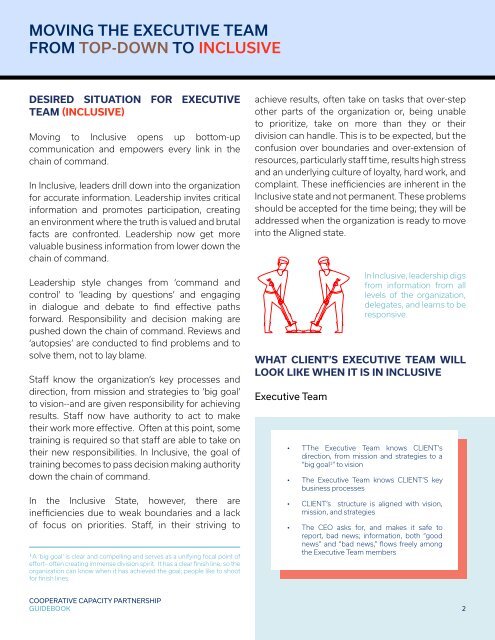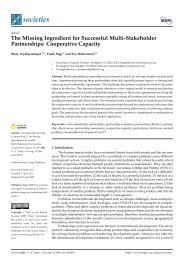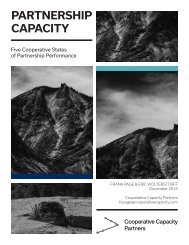An Example CCP Guidebook for Building Organizational Performance
Cooperative Capacity trains partners and implements quick organizational assessments. This publication is an example of the final report an organization would receive. In a short, customized report, the organization's current state is described, the desired state explained, and the general work plan for reaching the next higher state that is created with the client is presented.
Cooperative Capacity trains partners and implements quick organizational assessments. This publication is an example of the final report an organization would receive. In a short, customized report, the organization's current state is described, the desired state explained, and the general work plan for reaching the next higher state that is created with the client is presented.
Create successful ePaper yourself
Turn your PDF publications into a flip-book with our unique Google optimized e-Paper software.
MOVING THE EXECUTIVE TEAM<br />
FROM TOP-DOWN TO INCLUSIVE<br />
DESIRED SITUATION FOR EXECUTIVE<br />
TEAM (INCLUSIVE)<br />
Moving to Inclusive opens up bottom-up<br />
communication and empowers every link in the<br />
chain of command.<br />
In Inclusive, leaders drill down into the organization<br />
<strong>for</strong> accurate in<strong>for</strong>mation. Leadership invites critical<br />
in<strong>for</strong>mation and promotes participation, creating<br />
an environment where the truth is valued and brutal<br />
facts are confronted. Leadership now get more<br />
valuable business in<strong>for</strong>mation from lower down the<br />
chain of command.<br />
Leadership style changes from ‘command and<br />
control’ to ‘leading by questions’ and engaging<br />
in dialogue and debate to find effective paths<br />
<strong>for</strong>ward. Responsibility and decision making are<br />
pushed down the chain of command. Reviews and<br />
‘autopsies’ are conducted to find problems and to<br />
solve them, not to lay blame.<br />
Staff know the organization’s key processes and<br />
direction, from mission and strategies to ‘big goal’<br />
to vision--and are given responsibility <strong>for</strong> achieving<br />
results. Staff now have authority to act to make<br />
their work more effective. Often at this point, some<br />
training is required so that staff are able to take on<br />
their new responsibilities. In Inclusive, the goal of<br />
training becomes to pass decision making authority<br />
down the chain of command.<br />
In the Inclusive State, however, there are<br />
inefficiencies due to weak boundaries and a lack<br />
of focus on priorities. Staff, in their striving to<br />
A ‘big goal’ is clear and compelling and serves as a unifying focal point of<br />
ef<strong>for</strong>t– often creating immense division spirit. It has a clear finish line, so the<br />
organization can know when it has achieved the goal; people like to shoot<br />
<strong>for</strong> finish lines.<br />
achieve results, often take on tasks that over-step<br />
other parts of the organization or, being unable<br />
to prioritize, take on more than they or their<br />
division can handle. This is to be expected, but the<br />
confusion over boundaries and over-extension of<br />
resources, particularly staff time, results high stress<br />
and an underlying culture of loyalty, hard work, and<br />
complaint. These inefficiencies are inherent in the<br />
Inclusive state and not permanent. These problems<br />
should be accepted <strong>for</strong> the time being; they will be<br />
addressed when the organization is ready to move<br />
into the Aligned state.<br />
In Inclusive, leadership digs<br />
from in<strong>for</strong>mation from all<br />
levels of the organization,<br />
delegates, and learns to be<br />
responsive.<br />
WHAT CLIENT’S EXECUTIVE TEAM WILL<br />
LOOK LIKE WHEN IT IS IN INCLUSIVE<br />
Executive Team<br />
• TThe Executive Team knows CLIENT’s<br />
direction, from mission and strategies to a<br />
“big goal 1 ” to vision<br />
• The Executive Team knows CLIENT’S key<br />
business processes<br />
• CLIENT’s structure is aligned with vision,<br />
mission, and strategies<br />
• The CEO asks <strong>for</strong>, and makes it safe to<br />
report, bad news; in<strong>for</strong>mation, both “good<br />
news” and “bad news,” flows freely among<br />
the Executive Team members<br />
COOPERATIVE CAPACITY PARTNERSHIP<br />
GUIDEBOOK 2






